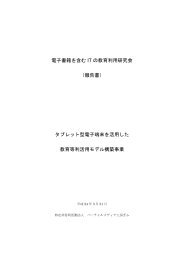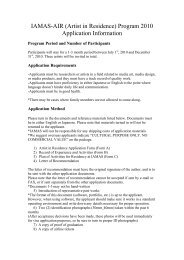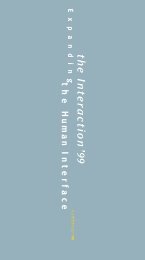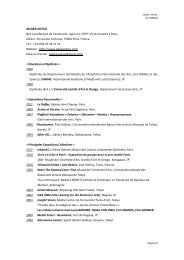Download the document (PDF, 1.6MB) - IAMAS
Download the document (PDF, 1.6MB) - IAMAS
Download the document (PDF, 1.6MB) - IAMAS
You also want an ePaper? Increase the reach of your titles
YUMPU automatically turns print PDFs into web optimized ePapers that Google loves.
One of 15.000 portraits Mobile photostudio<br />
Installation in Kobe, Japan<br />
ocean_v1<br />
Interactive media installation<br />
from Masayuki Akamatsu and Wolf Helzle<br />
International teamwork: The two media artists Masayuki<br />
Akamatsu (Japan) and Wolf Helzle (Germany) designed a<br />
new media artwork toge<strong>the</strong>r. It deals with <strong>the</strong> recognition<br />
of our individuality in relation to humankind and interacts<br />
with <strong>the</strong> audience.<br />
INSTALLATION INTERACTION EXTENSION<br />
Ocean_v1 is shown on a<br />
flatscreen, connected with an<br />
face detection system, based<br />
on an apple or windows computer.<br />
From a database with over<br />
15.000 human faces, which<br />
Helzle collected over <strong>the</strong> last<br />
years from around <strong>the</strong> world, a<br />
selection of similar faces is projected<br />
on to a flat surface at a<br />
speed of 60 faces per second.<br />
At this speed, it looks like only<br />
one single face is present, even<br />
though it is being generated<br />
from many different ones. Several<br />
similarities can be found,<br />
such as <strong>the</strong> distance between<br />
<strong>the</strong> left and right eye or <strong>the</strong><br />
distance between <strong>the</strong> nose and<br />
mouth... after a time, ano<strong>the</strong>r<br />
selection is shown.<br />
Fur<strong>the</strong>rmore <strong>the</strong> images are<br />
moved, scaled and rotated according<br />
to <strong>the</strong> audiences´ face<br />
movements. If <strong>the</strong> audience<br />
turns its head, <strong>the</strong> picture turns<br />
its head too. In addition, <strong>the</strong><br />
speed can be altered and <strong>the</strong><br />
image size can be scaled to<br />
eye- and head movements.<br />
The moment Wolf Helzle photograph<br />
<strong>the</strong> visitors in <strong>the</strong> exhibition,<br />
<strong>the</strong>ir faces immediately<br />
become a part of <strong>the</strong> database.<br />
This can be of interest<br />
especially when looking for<br />
someone´s face. For this reason,<br />
a special selection can<br />
also display <strong>the</strong> last projected<br />
portraits, or <strong>the</strong> portraits projected<br />
that whole day.
ocean_v1<br />
Interactive media installation<br />
from Masayuki Akamatsu and Wolf Helzle<br />
CONCEPT<br />
Part 1: Philosophy<br />
Since we saw <strong>the</strong> first photographs<br />
of our planet from space in <strong>the</strong> last<br />
century, it is actually clear ra<strong>the</strong>r that<br />
we come into a time of <strong>the</strong><br />
globalization. It is however still to<br />
be observed that individual humans<br />
with <strong>the</strong> globalization and <strong>the</strong>ir<br />
effects do ra<strong>the</strong>r heavily. Contrary<br />
to among o<strong>the</strong>r things <strong>the</strong> economy,<br />
in which <strong>the</strong> advantages of global<br />
proceedings and markets clearly one<br />
recognizes and one use/uses. The<br />
advantages for <strong>the</strong> particular are not<br />
so fast obvious, are not never<strong>the</strong>less<br />
only <strong>the</strong>m in <strong>the</strong> commercial, as for<br />
example to <strong>the</strong> easier travel. We<br />
stand for <strong>the</strong> challenge before that<br />
we have to understand and to<br />
integrate it in our daily actions that<br />
everyone of us is a part of entire<br />
mankind and that we can survive<br />
including our planet only as<br />
mankind, no longer only than single<br />
or Nation ego. Consciousness, a<br />
part of <strong>the</strong> 6 billion counting<br />
mankind to be, is worthwhile/<br />
necessary, flows never<strong>the</strong>less <strong>the</strong><br />
increase in value of <strong>the</strong> whole one<br />
immediately back on <strong>the</strong> in such a<br />
way adjusted particular. With <strong>the</strong><br />
available work ocean_v1 <strong>the</strong> artists<br />
offer to <strong>the</strong> public, as it were in each<br />
case as particulars with <strong>the</strong> whole „to<br />
play“, i.e. interact playful with<br />
„mankind“.<br />
Part 2: Technology.<br />
A video camera is being used in this<br />
work to take an audience’s face. The<br />
image is analyzed in real time, and<br />
<strong>the</strong> outline of <strong>the</strong> audience’s face and<br />
a position such as eyes, nose and<br />
mouth are grasped. This face<br />
information is checked with 15000<br />
and more face informations stored<br />
in <strong>the</strong> database, and a specific<br />
photograph of <strong>the</strong> face is chosen by<br />
some algorithm. The face<br />
photograph is adjusted so that it may<br />
correspond to <strong>the</strong> audience’s face<br />
perfectly and <strong>the</strong>y are displayed as<br />
<strong>the</strong> audience is fitting a mask.<br />
Therefore, he/she feels like looking<br />
in a mirror but his/her face is<br />
replaced in <strong>the</strong> face of o<strong>the</strong>r people.<br />
Part 3: Algorithm<br />
Some algorithm is used when <strong>the</strong><br />
face information of <strong>the</strong> database is<br />
checked with <strong>the</strong> audience’s face<br />
information and a face photograph<br />
is chosen. It is important what kind<br />
of algorithm to be used. It will vary<br />
<strong>the</strong> kind of <strong>the</strong> face to be displayed<br />
and <strong>the</strong> impression to <strong>the</strong> audience.<br />
Here are some algorithm principles<br />
as examples.<br />
- Choose <strong>the</strong> face which looks alike<br />
<strong>the</strong> audience<br />
- Choose <strong>the</strong> face which doesn’t look<br />
alike <strong>the</strong> audience<br />
- Choose <strong>the</strong> face by <strong>the</strong> place where<br />
it takes<br />
- Choose <strong>the</strong> face by <strong>the</strong> time when<br />
it takes<br />
Such algorithm comes to change with<br />
<strong>the</strong> time progress by amount of<br />
audience’s movement and <strong>the</strong><br />
duration of <strong>the</strong> time that <strong>the</strong> audience<br />
is standing and so on.<br />
EXAMPLE
ocean_v1<br />
Interactive media installation<br />
from Masayuki Akamatsu and Wolf Helzle<br />
Wolf Helzle, Germany Masayuki Akamatsu, Japan<br />
One of <strong>the</strong> central questions asked by <strong>the</strong> media artist<br />
Wolf Helzle is: “What is <strong>the</strong> relationship between <strong>the</strong><br />
individual and mankind?” He asks this question in performances,<br />
photography, videos and installations where he<br />
integrates people from all around <strong>the</strong> world. He works<br />
toge<strong>the</strong>r with musicians of different styles and o<strong>the</strong>r<br />
experimental art forms. Integrating <strong>the</strong> audience is an<br />
important part in his artwork. Over <strong>the</strong> last five years, for<br />
example, Wolf Helzle has collected more than 15.000<br />
portraits from around <strong>the</strong> world.<br />
Curriculum Vitae<br />
Born 1950 in Göppingen, South Germany<br />
1970 Studied Art in Stuttgart and Kassel with Prof. Harry<br />
Kramer.<br />
1976 work in <strong>the</strong> Soft- and Hardware industry.<br />
Since 1984 freelance media artwork.<br />
1998 Lecturer for Art and Media, Art seminar at <strong>the</strong> Freie<br />
Hochschule, Metzingen,<br />
2000 University lecturer for Media Art, Fachhochschule<br />
für Gestaltung, Schwäbisch Hall.<br />
Exhibition shortlist<br />
2004 Ogaki Biennale, <strong>IAMAS</strong> Institut for Advanced Media<br />
Art and Sciences, Japan<br />
2004 „e-Europe4all„ Derry, Nor<strong>the</strong>rn Ireland<br />
2004 Gallery 22, Stuttgart<br />
2004 „Biennale media_city seoul 2004“ Seoul, Südkorea<br />
2003 „Festival of Film and New Media“ Split, Croatia<br />
2003 „art bytes“, Festival Schloß Balmoral, Bad Ems<br />
2002 Württembergischer Kunstverein, Stuttgart<br />
2002 Kulturamt Lahr, city-performance-project<br />
2001 „FUTURE CITY“ Building art project, Stuttgart<br />
2001 Foro artistico, Hannover<br />
1998 European Media Art Festival,Osnabrück<br />
1998 „Inner spaces“ Staatsmuseum, Poznan, Poland<br />
1998 Gallery Guth Maas & Maas, Reutlingen<br />
Wolf Helzle Media Artist<br />
Helfferichstr. 8 D-70192 Stuttgart Germany<br />
phone +49.711.6070597 fax +49.711.6070598<br />
wolf@helzle.com http://www.helzle.com<br />
Masayuki Akamatsu produced many media artworks that<br />
employ computer and networking facilities, focusing on<br />
<strong>the</strong> relationship between an artwork and <strong>the</strong> audience<br />
and <strong>the</strong> autonomy of an artwork itself. His works include:<br />
„incubator“ (2000), which projects audio-visual events<br />
using fifty computers; „Time Machine!“ (2002), which<br />
visualizes <strong>the</strong> audience’s experience of time in real time;<br />
„Flesh Protocol“ (2002), which controls <strong>the</strong> performer’s<br />
body with a computer. He also performs live electronic<br />
music. He has not only performed as a solo artist, but<br />
also in many groups. He has published many books and<br />
organized events including <strong>the</strong> „DSP Summer School“.<br />
Curriculum Vitae<br />
1961 Born in Hyogo, Japan<br />
1980 Studied psychology at Kobe University<br />
1984 Work for <strong>the</strong> Kobe City Government<br />
1997 Associate Professor for Sound/Media Art, at <strong>IAMAS</strong><br />
2002 Professor at <strong>IAMAS</strong><br />
Exhibition/Concert Shortlist<br />
2004 ADADA, Seoul, Korea<br />
2004 Ars Electronica, Linz, Austria<br />
2004 fluctuating images, Stuttgart, Germany<br />
2004 ISEA, Helsinki, Finland<br />
2004 Intern. Festival of Art & Technology, Taipei, Taiwan<br />
2004 Ogaki Biennale, Ogaki, Japan<br />
2003 Bulgasari Festival, Seoul, Korea<br />
2003 West Japan Tour, Osaka, Fukuoka, etc.,Japan<br />
2003 Respond, Cambridge, UK<br />
2003 Robotic Music, Kobe, Japan<br />
2002 ISEA, Nagoya, Japan<br />
2002 Video Topique, Strasbourg, France<br />
2002 Media Art Festival, Hamamatsu, Japan<br />
2002 Trans Max Night, Kobe, Tokyo, Japan<br />
2001 Media Art Festival, Hamamatsu, Japan<br />
2000 Hon’ami Koetsu Exhibition, Philadelphia, USA<br />
1999 incubator, Kobe, Japan<br />
1998 infodepot, Ogaki, Tokyo, Japan<br />
Masayuki Akamatsu <strong>IAMAS</strong><br />
3-95 Ryouke,Ogaki 503-0014 JAPAN<br />
phone +81-584-75-6600 fax +81-584-75-6637<br />
aka@iamas.ac.jp http://www.iamas.ac.jp/~aka/






